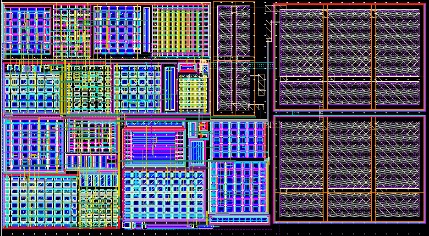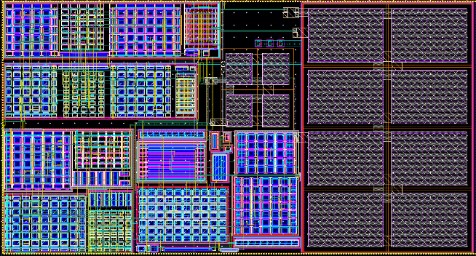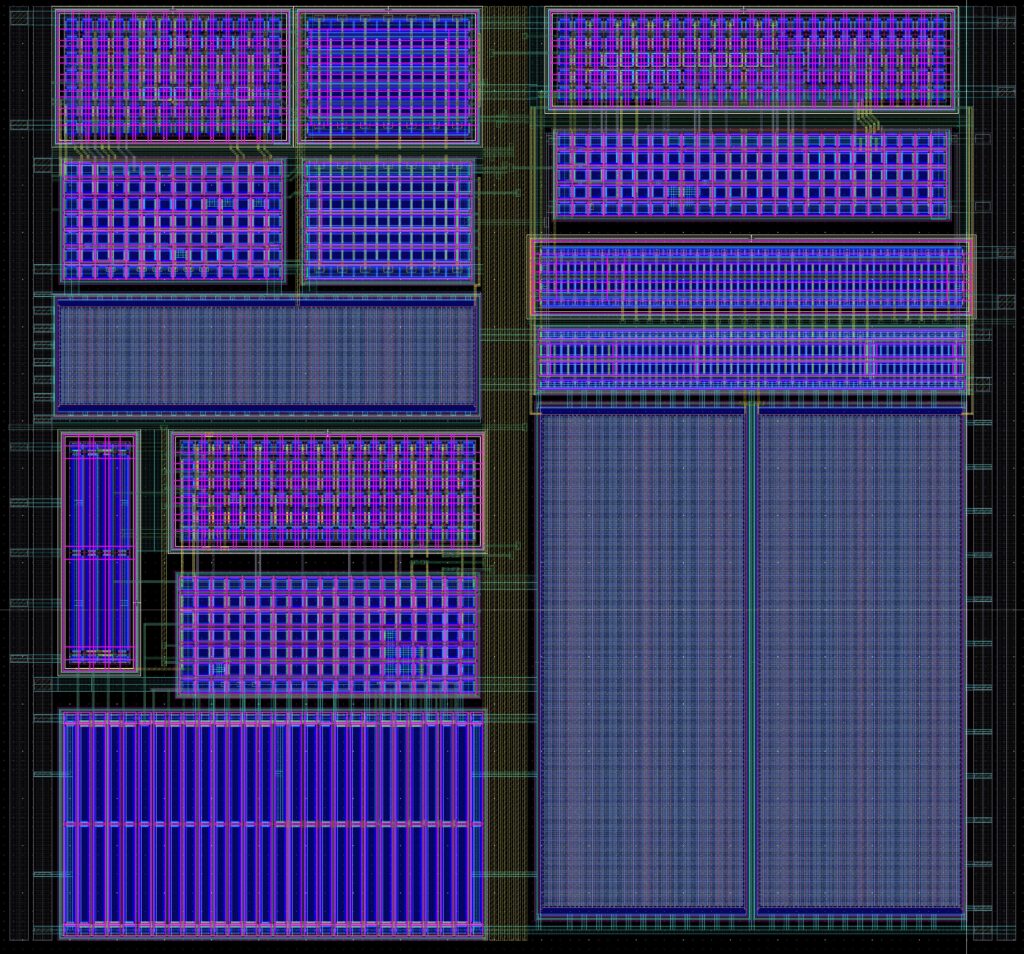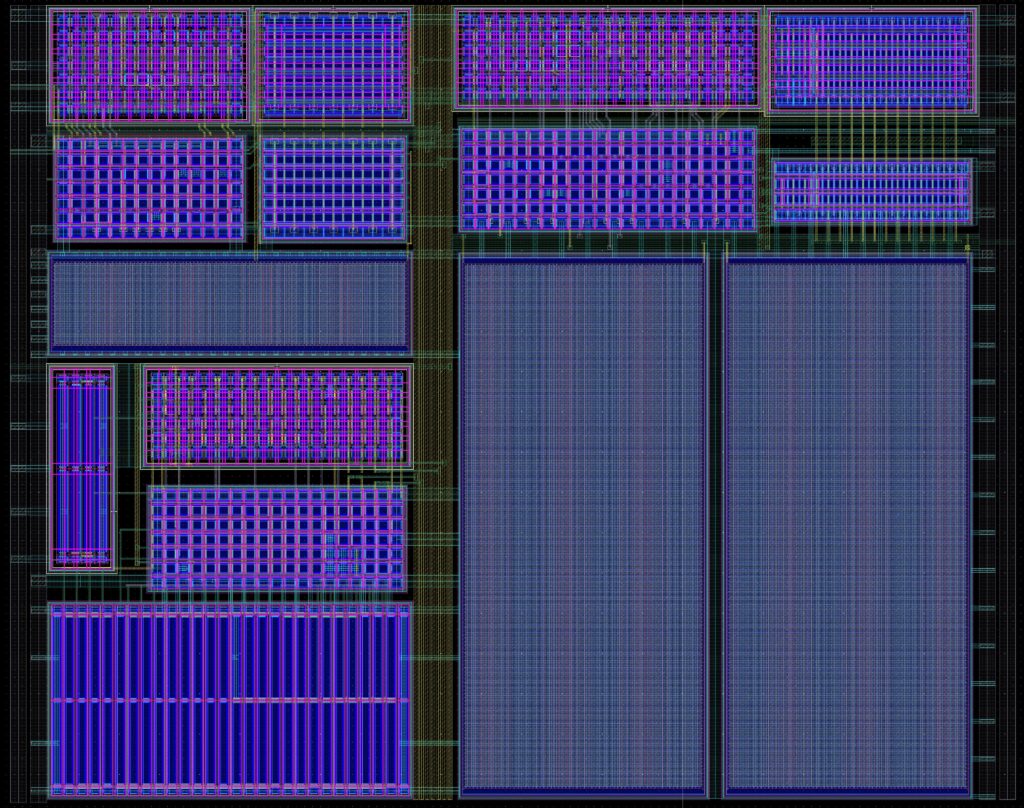Smart Amplifiers ≲150nA
4 US Patents Issued & Proof of Silicon
Introducing the Smart Amplifier (sAMP) series: an innovative range of patented CMOS amplifiers optimized for ultra-low power consumption, low noise, and moderate-speed operation. Designed to run in an ultra-low-power (e.g., 100nA), low-noise mode during steady-state conditions, these amplifiers seamlessly switch to high-speed operation when sensors detect a change, making them ideal for ‘always-on’ smart IoT and near-sensor AI applications. These amplifiers are essential in diverse industries, from consumer electronics and medical devices to micro-robotics and drones.
The sAMP family specifically targets the ultra-low-power, low-cost market segment, catering to applications where continuous, efficient monitoring is critical. The sAMP family includes start-up and power-off mechanisms. It also has an internal buffer to drive larger loads (e.g., 10s of Mega Ωs) in a low-power system-on-chip (SoC) environment. Testing of specific performance metrics is ongoing, with results forthcoming. For more information or to request testing, please contact us at sales@ailinear.com. Summary of the sAMP family traits are as follows:
- Low-noise buffer-amplifier with near rail-to-rail input-output and (class AB) push-pull output stage
- Patented method enables lowering noise in steady-state by an order of magnitude under apples-to-apples IQ operating currents while boosting slew-rate and settling-time in the face of imbalanced inputs
- Topology retains inherent FCTA traits: optimal PSRR and CMRR, and fast slew-rate and settling-time considering ultra-low operating currents
- Requiring neither passive capacitors nor resistors, lowers silicon cost and facilitates operations in subthreshold at ultra-low current
- The sAMP input stage can be calibrated or trimmed to improve input offset voltage. Typical VOFFSET ≈ ±5mv
- Typical VDDHIGH ≈ 2v for 180nm & ≈1v for 65nm;
- Typical VINPUT & VOUTPUT swing from power supply rails ≈ ±50mv for 180nm and ≈ ±25mv for 65nm
- Equipped with start-up, and power-down
- Includes an internal buffer (BUF) to drive larger loads (e.g. Mega Ωs) in a SoC
- Operating in subthreshold and requiring no resistors facilitate small silicon area and operations at ultra-low currents
- Based on 180nm & 65nm digital CMOS at TSMC and portable to smaller fabrication nodes.









Smart Amplifier Family Table Summary
Proof of Silicon Preliminary Specifications
Refer to each cell data sheet below for more details (please see disclaimers)
| Name | TSMC Fab Node | Cell Size (µm × µm) | IDD (nA) | Gain (dB) | PSRR (dB) | 10Hz VO Noise (μV/√Hz) | fu (KHz) | SR (v/ms) | ts (μs) |
|---|---|---|---|---|---|---|---|---|---|
| AMP1_1 | 180nm | 100 × 200 | 110 | 88 | 90 | 5 | 3 | 68 | <50 |
| AMP1_2 | 180nm | 105 × 190 | 130 | 80 | 90 | 7 | 2 | 130 | <25 |
| AMP1_3 | 180nm | 100 × 175 | 90 | 85 | 90 | 4 | 1 | 72 | <50 |
| AMP3&4_1 | 180nm | 160 × 140 | 95 | 95 | 85 | 6 | 5 | 121 | <35 |
| AMP3&4_2 | 180nm | 165 × 145 | 127 | 85 | 80 | 7 | 1 | 74 | <60 |
| AMP2_0 | 65nm | 105 × 110 | 82 | 92 | 92 | 7 | 8 | 150 | <30 |
| AMP2_1 | 65nm | 110 × 100 | 60 | 90 | 90 | 7 | 5 | 70 | <60 |
| AMP2_2 | 65nm | 125 × 100 | 100 | 88 | 80 | 8 | 7 | 140 | <30 |
| AMP2_3 | 65nm | 115 × 100 | 73 | 90 | 80 | 7 | 7 | 170 | <20 |
Notes: All sAMPs Fabricated in low-cost Digital CMOS. All sAMPs VOFFSET in the ~±5mV range without trim. Testing temperature ~ 27°C. External RLOAD utilized to increase quiescent current of sAMP buffer output in order to drive measurement gear load. Test condition for high VDD~2V for 180nm & VDD~1V for 65nm. Test conditions for low VDD~1.2V for 180nm & VDD~0.8V for 65nm. Temp test in progress. Gain and PSRR measured at higher frequencies and extrapolated back for gain at DC.
AMP1_1: Features (proof of 180nm silicon available):
- View Datasheet
- The sAMP’s IQ ≈ f(PTAT) → improved dynamic response’s TC
- The IDD ≈ f (IQ) ≈ f(μPMOS) ≈ f(RPMOS) ≠ f(VTH) → IDD less sensitive to manufacturing variations
- The RPMOS inside PTAT voltage loop coupled to VSS for lower VDD noise sensitivity
- At ultra-low IDD, utilizing current-mode gain-boost amplifiers in the FCTA gain stage
- The sAMP with internal class AB (push-pull) buffer (BUF) can drive larger loads (e.g. 10s of mega Ωs) in a low-power SoC
- Patented
AMP1_2: Features (proof of 180nm silicon available):
- View Datasheet
- The sAMP’s IQ ≈ f(PTAT) → improved dynamic response’s TC
- The IDD ≈ f (IQ) ≈ f(μPMOS) ≈ f(RPMOS) ≠ f(VTH) → IDD less sensitive to manufacturing variations
- The RPMOS inside PTAT voltage loop coupled to VSS for lower VDD noise sensitivity
- At ultra-low IDD, utilizing voltage-mode gain-boost amplifiers in the FCTA gain stage
- The sAMP with internal class AB (push-pull) buffer (BUF) can drive larger loads (e.g. 10s of mega Ωs) in a low-power SoC
- Patented
AMP1_3: Features (proof of 180nm silicon available):
- View Datasheet
- The sAMP’s IQ ≈ f(PTAT) → improved dynamic response’s TC
- The IDD ≈ f (IQ) ≈ f(μPMOS) ≈ f(RPMOS) ≠ f(VTH) → IDD less sensitive to manufacturing variations
- The RPMOS inside PTAT voltage loop coupled to VSS for lower VDD noise sensitivity
- At ultra-low IDD, utilizing regulated cascode (RGC) gain boosting in the FCTA stage
- The sAMP with internal class AB (push-pull) buffer (BUF) can drive larger loads (e.g. 10s of mega Ωs) in a low-power SoC
- Patented
AMP3&4_1: Features (proof of 180nm silicon available):
- View Datasheet
- The sAMP’s IQ ≈ f(PTAT) → improved dynamic response’s TC
- The IDD ≈ f (IQ) ≈ f(μPMOS) ≈ f(RPMOS) ≠ f(VTH) → IDD less sensitive to manufacturing variations
- The RPMOS inside PTAT voltage loop utilizing Wilson current mirrors for higher PSRR
- At ultra-low IDD, utilizing standard cascoded current mirrors in FCTA stage
- The sAMP with internal class AB (push-pull) buffer (BUF) can drive larger loads (e.g. 10s of mega Ωs) in a low-power SoC
- Patented
AMP3&4_2: Features (proof of 180nm silicon available):
- View Datasheet
- The sAMP’s IQ ≈ f(PTAT) → improved dynamic response’s TC
- The IDD ≈ f (IQ) ≈ f(μPMOS) ≈ f(RPMOS) ≠ f(VTH) → IDD less sensitive to manufacturing variations
- The RPMOS inside PTAT voltage loop utilizing Wilson current mirrors for higher PSRR
- At ultra-low IDD, utilizing a voltage-mode gain boosting in FCTA stage
- The sAMP with internal class AB (push-pull) buffer (BUF) can drive larger loads (e.g. 10s of mega Ωs) in a low-power SoC
- Patented
AMP2_0: Features (proof of 65nm silicon available):
- View Datasheet
- The sAMP’s IQ ≈ f(PTAT) → improved dynamic response’s TC
- The IDD ≈ f (IQ) ≈ f(μNMOS) ≈ f(RNMOS) ≠ f(VTH) → IDD less sensitive to manufacturing variations
- The RNMOS inside PTAT voltage loop coupled to VSS for less sensitivity to VDD noise
- At ultra-low IDD, utilizing voltage-mode gain boosting in FCTA stage
- The sAMP with internal class AB (push-pull) buffer (BUF) can drive larger loads (e.g. 10s of mega Ωs) in a low-power SoC
- Patented
AMP2_1: Features (proof of 65nm silicon available):
- View Datasheet
- The sAMP’s IQ ≈ f(PTAT) → improved dynamic response’s TC
- The IDD ≈ f (IQ) ≈ f(μNMOS) ≈ f(RNMOS) ≠ f(VTH) → IDD less sensitive to manufacturing variations
- The RNMOS inside PTAT voltage loop coupled to VSS for less sensitivity to VDD noise
- At ultra-low IDD, utilizing current-mode gain boosting in FCTA stage
- The sAMP with internal class AB (push-pull) buffer (BUF) can drive larger loads (e.g. 10s of mega Ωs) in a low-power SoC
- Patented
AMP2_2: Features (proof of 65nm silicon available):
- View Datasheet
- The sAMP’s IQ ≈ f(PTAT) → improved dynamic response’s TC
- The IDD ≈ f (IQ) ≈ f(μNMOS) ≈ f(RNMOS) ≠ f(VTH) → IDD less sensitive to manufacturing variations
- The RNMOS inside PTAT voltage loop coupled to VSS for less sensitivity to VDD noise
- At ultra-low IDD, utilizing voltage-mode gain boosting in FCTA stage
- The sAMP with internal class AB (push-pull) buffer (BUF) can drive larger loads (e.g. 10s of mega Ωs) in a low-power SoC
- Patented
AMP2_3: Features (proof of 65nm silicon available):
- View Datasheet
- The sAMP’s IQ ≈ f(PTAT) → improved dynamic response’s TC
- The IDD ≈ f (IQ) ≈ f(μNMOS) ≈ f(RNMOS) ≠ f(VTH) → IDD less sensitive to manufacturing variations
- The RNMOS inside PTAT voltage loop coupled to VSS for less sensitivity to VDD noise
- At ultra-low IDD, utilizing standard cascoded current mirrors in FCTA stage
- The sAMP with internal class AB (push-pull) buffer (BUF) can drive larger loads (e.g. 10s of mega Ωs) in a low-power SoC
- Patented
